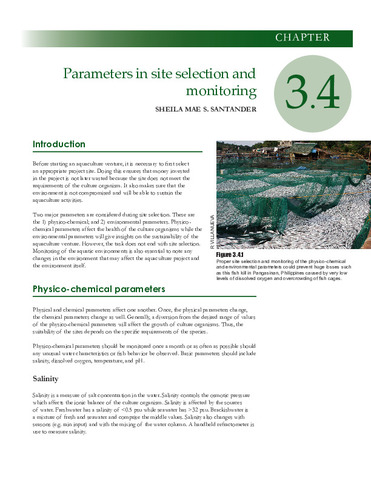Parameters in site selection and monitoring
| dc.contributor.author | Santander, Sheila Mae S. | |
| dc.date.accessioned | 2017-07-25T04:06:03Z | |
| dc.date.available | 2017-07-25T04:06:03Z | |
| dc.date.issued | 2009 | |
| dc.identifier.citation | Santander, S. M. S. (2009). Parameters in site selection and monitoring. In Training Handbook on Rural Aquaculture (pp. 43-47). Tigbauan, Iloilo, Philippines: Aquaculture Department, Southeast Asian Fisheries Development Center. | en |
| dc.identifier.isbn | 9789718511893 | |
| dc.identifier.uri | http://hdl.handle.net/10862/3127 | |
| dc.description.abstract | Before starting an aquaculture venture, it is necessary to first select an appropriate project site. Doing this ensures that money invested in the project is not later wasted because the site does not meet the requirements of the culture organism. It also makes sure that the environment is not compromised and will be able to sustain the aquaculture activities. Two major parameters are considered during site selection. These are the 1) physico-chemical; and 2) environmental parameters. Physico-chemical parameters affect the health of the culture organisms while the environmental parameters will give insights on the sustainability of the aquaculture venture. However, the task does not end with site selection. Monitoring of the aquatic environments is also essential to note any changes in the environment that may affect the aquaculture project and the environment itself. | en |
| dc.language.iso | en | en |
| dc.publisher | Aquaculture Department, Southeast Asian Fisheries Development Center | en |
| dc.title | Parameters in site selection and monitoring | en |
| dc.type | Book chapter | en |
| dc.citation.spage | 43 | |
| dc.citation.epage | 47 | |
| dc.citation.bookTitle | Training Handbook on Rural Aquaculture | en |
| dc.subject.asfa | salinity | en |
| dc.subject.asfa | temperature | en |
| dc.subject.asfa | dissolved oxygen | en |
| dc.subject.asfa | pH | en |
| dc.subject.asfa | turbidity | en |


 AQD Access only
AQD Access only